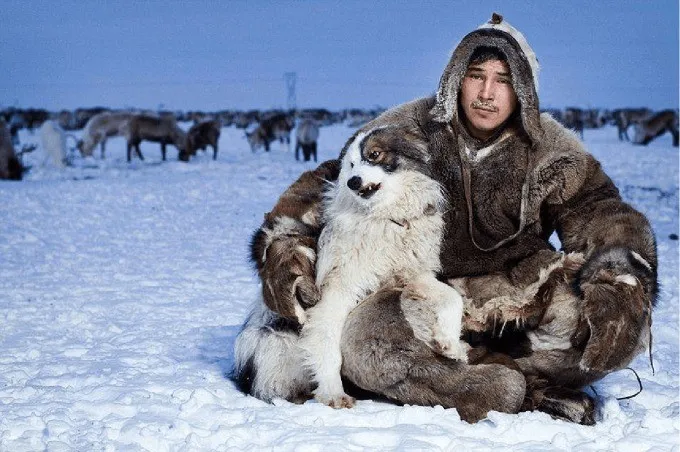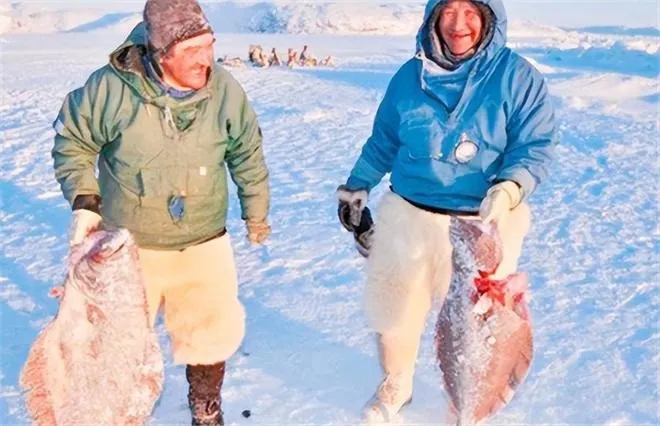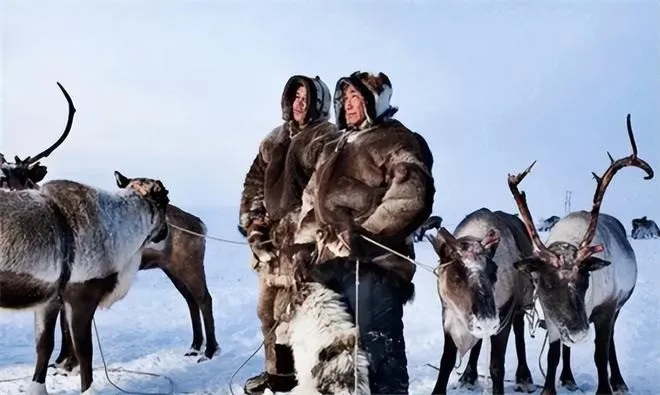In the eternal ice of the Arctic, where temperatures can plummet to -40°C (-40°F), the Eskimo (Inuit) people have thrived for millennia. Their survival is a testament to their extraordinary adaptation to the harsh environment, ingenuity, and resourcefulness in utilizing available materials. A prime example is their creation of light and warmth using unique oil lamps fueled by animal fat – a technique that is not merely about survival but also embodies profound cultural values.
The Inuit and the Harsh Arctic Life
The Arctic, the world’s northernmost region, often conjures images of a frozen wasteland, where life seems suspended in ice. Yet, for the Inuit, this is home, a land they have inhabited for generations. Life in the Arctic is fraught with challenges, from bone-chilling cold and fierce blizzards to the scarcity of vegetation. Every aspect of life, from hunting and travel to shelter construction, demands skill, strength, and exceptional adaptability.
Amidst this harsh environment, the Inuit have developed a unique culture, showcasing an astonishing harmony between people and nature. They not only survive but have also created a meaningful life, with customs, traditions, and survival skills passed down through generations. Among the secrets that enable them to endure the long winters and Arctic nights, the animal fat oil lamp stands out – an iconic invention reflecting the Inuit’s intelligence and resilience.

Igloo: A Warm Shelter Amidst the Ice
To combat the Arctic’s piercing cold, the Inuit ingeniously created the Igloo – a unique architectural marvel built entirely from snow and ice. While seemingly cold and precarious, the Igloo is remarkably effective as a shelter, offering excellent insulation. The secret lies in its dome-shaped structure and the special building material.
The snow blocks used for Igloos are not the soft, fluffy snow we know but rather dense, compacted snow, either naturally compressed or intentionally packed by the Inuit. By arranging these snow blocks in a spiral, forming a closed dome, the Igloo becomes sturdy and able to withstand significant pressure. The thick snow layer acts as natural insulation, blocking out cold winds and retaining heat inside.
The temperature inside an Igloo can be 20 to 40 degrees Celsius (36 to 72 degrees Fahrenheit) warmer than the outside, depending on the Igloo’s size and the number of occupants. This temperature difference, combined with the use of animal fat oil lamps, transforms the Igloo into a warm haven amidst the icy wilderness.

The Secret to Warmth and Light: Animal Fat Lamps
During the long nights and harsh winters of the Arctic, light and warmth are invaluable. The Inuit found a unique solution by using oil lamps made from animal fat. This is not just a survival tool but also an integral part of their cultural and spiritual life.
Inuit animal fat lamps are simple yet effective. The primary fuel is animal fat, typically from seals, whales, or caribou – animals abundant in the Arctic region and providing a plentiful source of fat. Animal fat is high in calories and burns slowly, producing a steady, low-smoke flame.
To make an oil lamp, the Inuit use a shallow bowl or dish made of stone or pottery. They place animal fat in the bowl and use a wick made from dried moss, grass, or plant fibers to ignite it. The wick draws the liquid fat, sustaining a bright flame. The oil lamp not only provides light in living spaces but also generates heat, contributing to warming the Igloo and melting ice for drinking water.
Materials and Crafting of Eskimo Oil Lamps
To create an effective animal fat oil lamp, the Inuit needed to prepare the following materials:
- Animal fat: This is the primary fuel for the oil lamp. Seal fat is most favored for its bright flame, low smoke, and pleasant odor. Whale and caribou fat are also commonly used. The fat is extracted from the thick layer of blubber beneath the skin of these animals.
- Wick: The wick plays a crucial role in drawing fat to the flame. The Inuit typically use dried moss, dry grass, or plant fibers, shredded and rolled into a wick. The wick material needs to be absorbent and slow-burning.
- Lamp Bowl: The lamp bowl holds the fat and wick. Lamp bowls are usually made from slate, soapstone, or pottery. Soapstone is preferred for its heat resistance and ease of carving. Lamp bowls are shaped like shallow pans or semicircles, sometimes with handles.
Oil Lamp Crafting Process:
- Fat Preparation: Animal fat is cleaned and gently melted to remove impurities. The liquid fat is then poured into the lamp bowl.
- Wick Making: Dried moss, grass, or plant fibers are shredded, tightly rolled, and shaped into a wick. One end of the wick is submerged in the liquid fat in the lamp bowl, and the other end is left exposed for ignition.
- Ignition: Fire is created using flint and steel or traditional methods to ignite the exposed end of the wick. As the wick burns, it draws liquid fat from the bowl, sustaining the flame.
- Lamp Adjustment: To adjust the brightness and size of the flame, the Inuit can adjust the length of the wick or the amount of fat in the bowl.

Applications of Oil Lamps in Eskimo Life
Animal fat oil lamps are not just a source of light and warmth but also play a vital role in many other aspects of Inuit life:
- Lighting: Oil lamps provide soft light, enabling the Inuit to live, work, and socialize inside the Igloo at night or during dark winter days.
- Heating: The heat from oil lamps contributes to raising the temperature inside the Igloo, mitigating the harsh cold and creating a more comfortable living environment.
- Cooking: Oil lamps can be used to melt ice for drinking water, warm food, or cook simple meals.
- Community Life: The light of oil lamps creates a cozy atmosphere where family and community members gather, chat, tell stories, and perform traditional rituals.
- Culture and Spirituality: Animal fat oil lamps hold deep cultural and spiritual significance for the Inuit. The flame is seen as a symbol of life, hope, and connection to ancestors.
Other Unique Aspects of Eskimo Culture
Besides animal fat oil lamps, Inuit culture encompasses many other unique and fascinating elements, demonstrating their remarkable adaptation to the Arctic environment:
- Clothing: The Inuit wear layered clothing made from animal hides, furs, and sinews, providing effective warmth and wind protection. The parka with a hood is a signature garment of the Inuit.
- Cuisine: The Inuit diet primarily consists of meat and fat from animals such as seals, whales, caribou, and fish. They eat meat raw or cooked, maximizing the nutritional value from animals to maintain health in the harsh environment.
- Transportation: The Inuit use dog sleds and kayaks for transportation across snow, ice, and water. Dog sleds are a fast and efficient means of travel over icy terrain, while kayaks enable hunting and travel on the sea.
- Art and Craftsmanship: The Inuit are renowned for their carvings in ivory, bone, and stone. They create intricate artworks that reflect their life, culture, and beliefs.

Modern Inuit and New Challenges
Today, the lives of the Inuit are undergoing significant changes due to the impact of modern civilization and climate change. Many Inuit have moved to modern settlements, gaining access to education, healthcare, and technology. However, they continue to preserve and promote their traditional cultural values, including the skill of making animal fat oil lamps.
Climate change is causing adverse effects on the Arctic environment, threatening the Inuit way of life. Melting ice, rising sea levels, changes in marine ecosystems, and declining animal populations are major challenges they face. Despite these challenges, the Inuit remain resilient, striving to adapt and protect their culture and traditions in a new context.
Conclusion
The Inuit method of making oil lamps from animal fat is not just a unique survival technique but also a symbol of creativity, adaptability, and the deep connection between humans and nature. The small oil lamp has illuminated Inuit life in the Arctic night, warmed Igloo homes, and nurtured a distinctive culture. Learning about Inuit animal fat lamps helps us further appreciate traditional cultural values and glean valuable lessons about human resilience, ingenuity, and adaptability in the face of life’s harsh challenges.